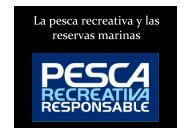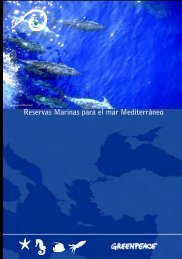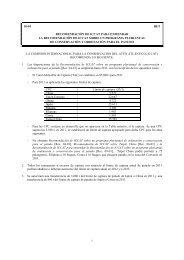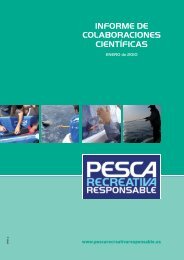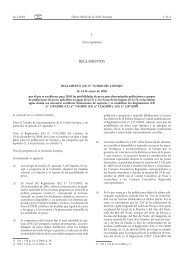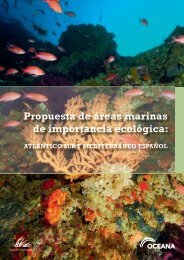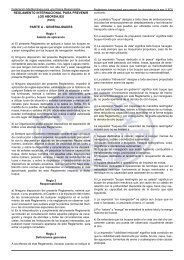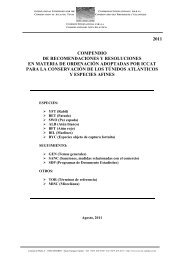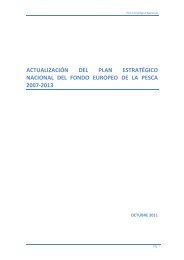C. hippurus - Confederación Española de Pesca Recreativa ...
C. hippurus - Confederación Española de Pesca Recreativa ...
C. hippurus - Confederación Española de Pesca Recreativa ...
You also want an ePaper? Increase the reach of your titles
YUMPU automatically turns print PDFs into web optimized ePapers that Google loves.
DOLPHINFISH (C. <strong>hippurus</strong>) RECREATIONAL<br />
FISHING IN THE MEDITERRANEAN SEA, A<br />
THEORETICAL TOOL FOR SCIENTISTS AND<br />
MANAGERS<br />
A CopeMed II contribution to:<br />
CopeMed II - MedSudMed Workshop on Fisheries<br />
and appraisal of Coryphaena <strong>hippurus</strong><br />
5-6 July, 2011<br />
Palermo, Italy<br />
Juan A. Camiñas<br />
FAO-CopeMed II, Coordinator<br />
Málaga (Spain), November 2011
CopeMed II Occasional Paper Nº 4<br />
(GCP/INT/028/SPA – GCP/INT/006/EC)<br />
CopeMed II (Co-ordination to Support Fisheries Management in the Western and<br />
Central Mediterranean) is a project un<strong>de</strong>r the responsibility of the Fisheries and<br />
Aquaculture Department of the Food and Agriculture Organization of the United<br />
Nations (FAO), executed by the Marin and Inland Fisheries Service and<br />
Coordinated from the Office of the Project in Málaga (Spain).<br />
CopeMed II is financed by the DG Mare of the European Commission and the<br />
Government of Spain.<br />
CopeMed II Occasional Papers is a series of non peer<br />
reviewed documents prepared in the frame of the<br />
activities of the Project in cooperation with the CopeMed<br />
II countries, other FAO Mediterranean projects or by<br />
other reasons for: technical support to international<br />
meetings, working group meetings, joint assessment<br />
meetings on shared stocks within the CopeMed region<br />
and with other FAO projects; and report concerning other<br />
activities.<br />
The documents inclu<strong>de</strong>d in the Occasional Papers series<br />
are based on work carried out by researchers from the<br />
institutions involved in CopeMed II, on contributions<br />
prepared by external experts to the project and on joint<br />
works organized by or with the support of other FAO<br />
projects.<br />
CopeMed II Occasional Papers are available on the<br />
website of the CopeMed II Project www.faocopemed.org<br />
For reference, this document should be cited as follow:<br />
Camiñas J.A., 2011. Dolphinfish (C. <strong>hippurus</strong>) recreational fishing in the Mediterranean Sea, a<br />
theoretical tool for scientists and managers. A CopeMed II contribution to the CopeMed II -<br />
MedSudMed Workshop on Fisheries and appraisal of Coryphaena <strong>hippurus</strong> (Palermo, Italy. 5-6<br />
July, 2011). GCP/INT/028/SPA-GCP/INT/006/EC. CopeMed II Occasional Paper Nº 4: 7 pp.<br />
1
1. Introduction<br />
The participation of recreational fishing actors in the management process of some<br />
fisheries resources is an opportunity for fishermen, scientists and administrations to<br />
achieve the goals of the Co<strong>de</strong> of Conduct for responsible fisheries of the FAO (FAO,<br />
1995) and to improve the implementation of the principles and recommendations of the<br />
Ecosystem Approach to Fisheries Management (EAF) in the Mediterranean Sea, in the<br />
framework of the GFCM.<br />
The Co<strong>de</strong> of Conduct promote the participation of all the interested domestic parties,<br />
having a legitimate interest in the use of fisheries resources, in the management process,<br />
by establishing arrangements for consulting them to gain their collaboration in achieving<br />
responsible fisheries, and the (EAF) recommends the stakehol<strong>de</strong>rs participation. Such<br />
participation may be implemented at many different levels of involvement of the<br />
stakehol<strong>de</strong>rs in the management process in data collection, knowledge-building, option<br />
analysis, <strong>de</strong>cision-making and even implementation, including enforcement (Garcia et al,<br />
2003).<br />
The GFCM recognizes the important role of the recreational fisheries in fishery<br />
management. Moreover, in 2010, a GFCM transversal meeting on recreational fisheries<br />
was un<strong>de</strong>rtaking providing with recommendations to the 2010 GFCM meeting.<br />
2. Dolphinfish fisheries in the Mediterranean Sea. The Spanish situation<br />
Dolphinfish is an epipelagic species inhabiting open waters, but also approaching the<br />
coast following ships and assembling in small groups below floating objects. It has<br />
pelagic eggs and larvae and spawning generally occurs during summer (June to<br />
September). It is worldwi<strong>de</strong> distributed in tropical and subtropical seas and is present in<br />
the Mediterranean Sea. Fishing aggregation <strong>de</strong>vices (FADs) are used to concentrate<br />
Dolphinfish before the nets are set. It is caught by trolling and by tuna longlining, and<br />
also occasionally with purse seines and driftnets (FAO Fish-Fin<strong>de</strong>r, 2011).<br />
A traditional small-scale fishery is carried out in the central Mediterranean (Sicily, Malta<br />
and Tunisia) and western part of the basin (Majorca Island) during summer-fall using<br />
FADs. This highly migratory middle size pelagic fish seems to be a single stock in the<br />
central-western Mediterranean and should be jointly managed (COPEMED, 2003). The<br />
Balearic island artisanal fishery (Masutti & Morales Nin, 1995) means to be the most<br />
important in Spanish waters.<br />
This species is also recognized as a premier game and food fish wherever it is found.<br />
Historically harvested almost wholly by recreational fishermen around the world, only in<br />
recent <strong>de</strong>ca<strong>de</strong>s caught the attention of commercial fishermen. Today the species is a<br />
shared stock between recreational and commercial interests (Hammond, Cooperative<br />
Science Services, LLC).<br />
The bearing of recreational fisheries worldwi<strong>de</strong> and in the Mediterranean is very<br />
important, consi<strong>de</strong>ring that only U.S. sports fishermen harvested more than 1.45 million<br />
Dolphinfish from the Gulf of Mexico, Atlantic and Caribbean in 2008. (MRFSS Data,<br />
Dolphinfish Research Newsletter. August 2009).<br />
2
Recreational fisheries are an important regional issue for the GFCM. A recent report of<br />
the GFCM (GFCM, 2011) stated that basic recreational fisheries resource needs to be<br />
well managed but information on the state and trends are largely lacking to support<br />
recreational fishing regulations and management.<br />
Recreational fisheries in Spanish Mediterranean waters are well <strong>de</strong>veloped, and the<br />
Majorca recreational fisheries targeting Dolphinfish are well known by professional<br />
artisanal fishermen and are or could be questioned due to conflicts between users.<br />
According to the Confe<strong>de</strong>ration Española <strong>de</strong> <strong>Pesca</strong> <strong>Recreativa</strong> Responsable, Spanish<br />
recreational fisheries consist of 100.000 boats and the socio-economic impact is 1.000<br />
million € annually. This Confe<strong>de</strong>ration is an observer of the GFCM, participating in<br />
different sub committees.<br />
3. An approach to recreational fisheries information and data on Dolphinfish<br />
Recreational fisheries are very important in all the Mediterranean countries. Some studies<br />
on recreational fisheries in Mediterranean countries were presented during the transversal<br />
workshop of the GFCM (2010) referred to Italy (Colella et al., 2010), Balearic Islands in<br />
Spain (Morales-Nin and Palmer, 2010), Turkey (Unal and Özgül, 2010), Maroc (Zahri<br />
and Ab<strong>de</strong>llaoui) including one presentation on spearfishing in Spain (Sagué Pla, 2010).<br />
Recreational un<strong>de</strong>rwater fisheries are practically unknown from the point of view of the<br />
number of fishermen, target species or production.<br />
Studies on Dolphinfish captured, recreational fisheries and spearfishing are very rare. In<br />
this document we propose to explore new digital formats that inclu<strong>de</strong> information on this<br />
species in the Mediterranean Sea in or<strong>de</strong>r to improve our knowledge and the biological<br />
information as well as looking for new possibilities of monitoring and basic data<br />
gathering. The aim is to facilitate the organisation of a monitoring framework including<br />
most of the recreational fisheries information set as requested by the GFCM WG on<br />
recreational fisheries.<br />
A preliminary review of existing information on Spanish sport fishing fora websites has<br />
begun in or<strong>de</strong>r to investigate whether biological and fishing information provi<strong>de</strong>d by<br />
sport fishermen could be used to know more about the biology and ecology of<br />
Dolphinfish in the Mediterranean. The review was done without intending to obtain<br />
statistical data but to investigate whether that information could be used as an additional<br />
valid source for researching into the state of the resource and applying this approach in<br />
the Mediterranean region.<br />
From the information of recreational fisheries websites and from the information<br />
provi<strong>de</strong>d by the fishermen in digital fora, some conclusions that could improve<br />
un<strong>de</strong>rstanding of this species in the Spanish Mediterranean have been drawn and in some<br />
way facilitate the <strong>de</strong>velopment of a database sport fishing of this species.<br />
As first attempt to test this methodology three websites were reviewed: the web<br />
www.pescamediterraneao2.com, which inclu<strong>de</strong>s information from Spanish fishermen in<br />
the Mediterranean; the fishing forum web<br />
http://foro.lataberna<strong>de</strong>lpuerto.com/showthread.php?t=22489; and the website of the<br />
3
Spanish Confe<strong>de</strong>ration of Responsible Recreational Fisheries<br />
(http://www.pescarecreativaresponsable.es), that is a confe<strong>de</strong>ration that brings together<br />
13 associations and fe<strong>de</strong>rations of recreational fishing from boats on the Spanish coast.<br />
4. The recreational Dolphinfish fishery in Spanish Mediterranean Sea: Preliminary<br />
results<br />
The information obtained that can be useful for the WG inclu<strong>de</strong>: date, fisherman base<br />
location, fishing area, fishing <strong>de</strong>pth, fishing period of the year, number of catch, weight<br />
of the specimens, type of gear used, the <strong>de</strong>stination of specimens (consumption,<br />
distribution) and so on. A summary of the information obtained from the visited websites<br />
is shown next:<br />
Gear types and fishing methods: according to these forums, Dolphinfish boat fishing is<br />
carried out in very different ways, from spinning and jigging to the more usual trolling. It<br />
is also caught baiting the water with sardine to attract them. Since the species tends to<br />
shelter, it is caught near the feeding and fattening aquaculture cages and using floating<br />
<strong>de</strong>vices. It is also mentioned that using trolls, once a specimen is attracted to the boat, if<br />
left hooked in the water, the presence of the first one usually attract new specimens<br />
increasing the boat captures.<br />
Fishing strategy and fishing methods: it is highly varied, from which the one that go<br />
fishing after consulting in a forum some information about the presence of specimens in<br />
their area, to the ones that have information about the fishing season and abundance<br />
because of their greater experience, or those mentioning that "we must observe any<br />
movement of seabirds, floating <strong>de</strong>bris or some fish shoals, that will guarantee a good<br />
fishing". Some time <strong>de</strong>tection of Dolphinfish schools is ma<strong>de</strong> by observing the sea birds<br />
flying around FADs, the movement of the water surface, or other indicators.<br />
Depth and fishing zones: are varied, from 60-70 m <strong>de</strong>ep (Saint Pedro <strong>de</strong>l Pinatar,<br />
southern Murcia) to over 300 m (<strong>de</strong>ep-sea for fishing competition) but it seems that<br />
sometimes can be caught near the coast ("I saw 15 m from the coast the -queen of<br />
Dolphinfish-, nearly 1m long one") or in lower <strong>de</strong>pths (20 to 30 m in January in<br />
Tarragona), or even in some bays (Alicante, December 2003). Fishing is reported in<br />
Tarragona, Baleares, Valencia, Alicante, Murcia and Cabo <strong>de</strong> Gata (Andalucía).<br />
Fishing seasons: the main fishing season runs from June to September (although in<br />
November is reported in Majorca). Nevertheless captures are reported during the whole<br />
year: in April 2004 a fisherman from Barcelona says: "I caught fifteen Dolphinfish and I<br />
returned more than half of them to the water as they were so small, keeping the rest that<br />
would not exceed 1 Kg". The fishing season varies from one area to another, being able<br />
to get valuable information on the distribution areas and sizes in different mainland<br />
coastal and Balearic Islands areas: "In June 2003, in Javea-Moraira it was caught a<br />
specimen 15-25 miles from the coast. In Valencia, November 22, one was caught 30<br />
miles from the coast. In Almería, very few reported in November 2003".<br />
Sizes and / or weight of specimens catch: data tables can be ma<strong>de</strong> with sizes and / or<br />
specimens weights information, in different areas and periods of the year. For example, it<br />
4
was reported: "seven small Dolphinfish caught, all with little more than several inches (><br />
20 cm) on November 11, 2003. In October, in Alicante, 200 gr specimens. In December,<br />
one specimen with a little less than 1 Kg in southern of Salou (Tarragona)”. What it is<br />
clear from the anglers’ information is that mean length composition of the Dolphinfish<br />
increase during the summer fishing season in Spanish waters.<br />
Biology of the species: from October to December and in some cases in January, 200 gr<br />
specimens are reported (Alicante, October 2003), and 1 Kg specimen (Tarragona,<br />
December). Such kind of data may provi<strong>de</strong> information about areas and recruitment on<br />
the Spanish coast. In this period it is also commented that "the size is increased the entire<br />
months of September and October, and then in November they disappear”.<br />
Abundance in the sea: most fishermen give information about their fishing zones and if<br />
the fishing is good or not, which could i<strong>de</strong>ntify some key areas in the sea where adults<br />
and juveniles are concentrated: "Near Denia there is a lot of Dolphinfish (April 2003),<br />
most specimens with more than 1 Kg and some with more than 2kg".<br />
Total catch per vessel: only some information of total catch, primarily in number of<br />
specimens (from 200 to 1 or 2, with varied sizes). The comments, sometimes comment<br />
total catch: "Catch may reach nearly 200 kg in 1 hour time of 3-4 Kg specimens in<br />
Tabarca. In August, fish over 2 kg are caught in Alicante. 150-200 Dolphinfish were<br />
caught 3 miles from San Carlos <strong>de</strong> la Rápita, in 6 hours, in 2007".<br />
Spanish Confe<strong>de</strong>ration of Responsible Recreational Fishing<br />
(http://www.pescarecreativaresponsable.es): it is a non-governmental, non-profit<br />
organization that brings together several associations and fe<strong>de</strong>rations of recreational sea<br />
fishing in Spain. It is committed to promote the practice of responsible recreational<br />
fishing, the spread of its co<strong>de</strong> of conduct based on respect for the marine environment<br />
and sustainability of fishery resources. According this Confe<strong>de</strong>ration, the Spanish fishery<br />
represents 100.000 boats and the Socio-economic impact is 1.000 million € annually.<br />
This Confe<strong>de</strong>ration is involved in scientific activities (mainly tagging programs) in<br />
collaboration with Spanish scientific institutions: IEO, CSIC and AZTI, three important<br />
marine research institutions in Spain.<br />
Registers from National and International competition<br />
Data on catch could also be obtained through the national and international competitions<br />
registers. As an example we inclu<strong>de</strong> here the International Fe<strong>de</strong>ration of Sporting Sea-<br />
Angling, (http://www.fipsmer.org) with a register called F.I.P.S./M. Competition World<br />
Record Catches with different lists where they inclu<strong>de</strong> the biggest captures during<br />
championships, including two Dolphinfish:<br />
Dolphinfish C. <strong>hippurus</strong>; 13,0 Kg; date: 24.06.2003 in Dakar, Senegal during the<br />
World Championship; fisher: Carlos Garin, Spain<br />
Dolphinfish C. <strong>hippurus</strong>; 20,4 Kg; date: 26.08.2003 in Alicante , Spain during the<br />
Club Championship; angler: Cristobal Miravet Sturm, Spain<br />
This second record corresponds to a Dolphinfish captured in the Mediterranean.<br />
5
Tagging research programs on Dolphinfish<br />
The USA Marine Resources Division of the South Carolina Department of Natural<br />
Resources (SCDNR) initiated a study on Dolphinfish in 2002 adopting a tagging program<br />
in collaboration with the recreational anglers (http://www.dolphintagging.com). The<br />
Tagging Study is a scientific research project conducted to the fishermen with the aim of<br />
establishing the temporal and spatial occurrence, movement patterns and essential habitat<br />
of the species in the USA territorial waters, Gulf of Mexico, Western North Atlantic and<br />
Caribbean Sea. It is also inten<strong>de</strong>d to foster more research on the biology and behaviour<br />
of Dolphinfish. The program has been extremely successful, having more than 11,000<br />
fish marked with the majority released along the U.S. Atlantic coast.<br />
2005 SPECIAL RECAPTURE MAPS 2010 RECAPTURES MAP<br />
Dolphinfish tagged off the U.S. East Coast have travelled to southern Azores Islands in<br />
the Eastern North Atlantic, Puerto Rico, Antigua, St. Kitts, Venezuela, Mexico and Cuba.<br />
The Confe<strong>de</strong>ración Española <strong>de</strong> <strong>Pesca</strong> <strong>Recreativa</strong> Responsable is associated to this<br />
tagging program and could be an important contributor to this activity in Spain.<br />
5. Some conclusions and recommendations<br />
Recreational fisheries targeting Dolphinfish in western Mediterranean are an<br />
important annual activity for anglers based in several ports of Balearic Islands,<br />
Catalonia, Valencia and north of Cabo <strong>de</strong> Gata in Spain.<br />
The total catch and the number of anglers involved in the capture of this species in<br />
Spain are unknown at present.<br />
Web pages of professionals and digital fora on recreational fisheries are an important<br />
source of information related to the biology, distribution, fishing periods and fishing<br />
zones, weight and sizes, production, fishing methods and environmental variables<br />
(fishing <strong>de</strong>pths, sea state, winds, etc).<br />
Registers from National and International competitions could be a source of<br />
information on Dolphinfish.<br />
Information provi<strong>de</strong>d by recreational fishers could be incorporated to a data base of<br />
the Spanish recreational Dolphinfish fishery.<br />
Catch occurs from January to December in coastal and offshore areas with peaks of<br />
captures during the end of the summer and autumn.<br />
Dolphinfish average length composition in Spanish Mediterranean waters increase from<br />
April-May until the end of October.<br />
Target sizes (>1Kg) disappear in some areas in November.<br />
6
During October, November and December anglers from Majorca and from coastal<br />
areas (Barcelona, Alicante) report of catch of small Dolphinfish (




